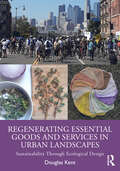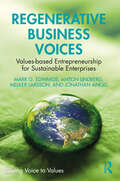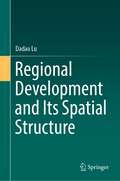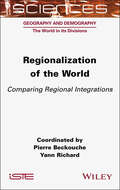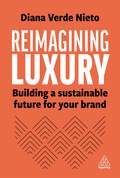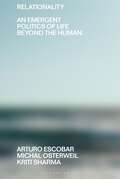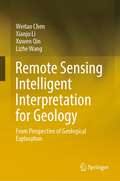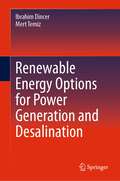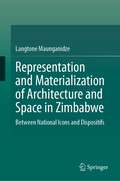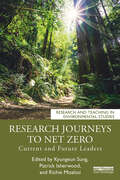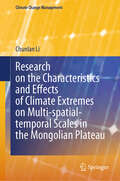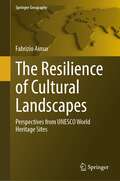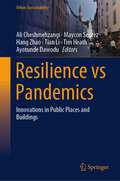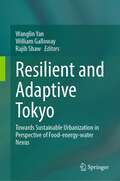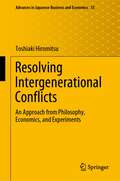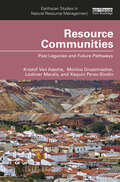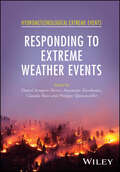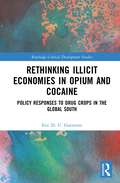- Table View
- List View
Regenerating Essential Goods and Services in Urban Landscapes: Sustainability Through Ecological Design
by Douglas KentHow do we provide for and nurture millions of people without destroying the planet in the process? Author Doug Kent, an environmental specialist, believes a vital element in the solution is recognizing that urban landscapes are an essential partner in everyone’s wellbeing. He argues that urban landscapes can and must work harder.Urban landscapes can provide part of our energy needs, help cool our buildings and public spaces, help us make the most of our precious water. They can also help combat air pollution and reduce the likelihood of allergies and asthma. They can provide landscape materials and even contribute to our timber supply. Doug also advocates turning landscapes into a food source, and/or a perfumery, pharmacy, soap shop, or craft store.Doug has over 12 years of research in this book. He has spent years doing literature reviews, and many more years concocting, consuming, crafting, distilling, propagating, retting, sawing, sowing, and weaving its many recommendations. He has also travelled the length and width of California many times to interview the people and businesses already doing this incredible work.Regenerating Essential Goods and Services is not a manifesto. It is a user’s manual. You are the creative and energetic force that will ultimately drive sustainability and regeneration. Let’s go.
Regenerating Essential Goods and Services in Urban Landscapes: Sustainability Through Ecological Design
by Douglas KentHow do we provide for and nurture millions of people without destroying the planet in the process? Author Doug Kent, an environmental specialist, believes a vital element in the solution is recognizing that urban landscapes are an essential partner in everyone’s wellbeing. He argues that urban landscapes can and must work harder.Urban landscapes can provide part of our energy needs, help cool our buildings and public spaces, help us make the most of our precious water. They can also help combat air pollution and reduce the likelihood of allergies and asthma. They can provide landscape materials and even contribute to our timber supply. Doug also advocates turning landscapes into a food source, and/or a perfumery, pharmacy, soap shop, or craft store.Doug has over 12 years of research in this book. He has spent years doing literature reviews, and many more years concocting, consuming, crafting, distilling, propagating, retting, sawing, sowing, and weaving its many recommendations. He has also travelled the length and width of California many times to interview the people and businesses already doing this incredible work.Regenerating Essential Goods and Services is not a manifesto. It is a user’s manual. You are the creative and energetic force that will ultimately drive sustainability and regeneration. Let’s go.
Regenerative Business Voices: Values-based Entrepreneurship for Sustainable Enterprises (Giving Voice to Values)
by Mark G. Edwards Anton Lindberg Melker Larsson Jonathan AngelThis is a book about the future of sustainability. Regenerative Business Voices: Values-based Entrepreneurship for Sustainable Enterprises tells the stories of four regenerative organizations and the people who have founded them and guided them towards sustaining futures.Regenerative sustainability recognizes the urgency of transforming organizations to reverse the unsustainable pathways we are currently on. Regenerative businesses do not simply do less harm, or produce zero emissions, or optimize the efficient use of natural resources; they also restore and enhance well-being in social and ecological systems. The stories presented here are analyzed using the business ethics approach called Giving Voice to Values (GVV). Through the application of GVV principles, we uncover the processes involved in how regenerative businesses develop and function, and gain insights into how business leaders voice their deep convictions, overcome silencing rationalizations, normalize their execution of personal choice, discover deep purpose in their work, and draw on their personal histories to create new ways of doing business. We present and analyze these cases to understand how and why expressing values can be so crucial in developing sustainable businesses, and to provide practical examples of how individuals can generate enthusiasm, counter objections, gain allies, and prepare for and practice conversations that help them move forward.The book offers managers and sustainability consultants a new way of understanding some of the central dynamics involved in business ethics and organizational change for sustainability. It will be immensely valuable to educators, business students, and practitioners interested in sustainability, environmental business ethics, and corporate social responsibility topics.
Regenerative Business Voices: Values-based Entrepreneurship for Sustainable Enterprises (Giving Voice to Values)
by Mark G. Edwards Anton Lindberg Melker Larsson Jonathan AngelThis is a book about the future of sustainability. Regenerative Business Voices: Values-based Entrepreneurship for Sustainable Enterprises tells the stories of four regenerative organizations and the people who have founded them and guided them towards sustaining futures.Regenerative sustainability recognizes the urgency of transforming organizations to reverse the unsustainable pathways we are currently on. Regenerative businesses do not simply do less harm, or produce zero emissions, or optimize the efficient use of natural resources; they also restore and enhance well-being in social and ecological systems. The stories presented here are analyzed using the business ethics approach called Giving Voice to Values (GVV). Through the application of GVV principles, we uncover the processes involved in how regenerative businesses develop and function, and gain insights into how business leaders voice their deep convictions, overcome silencing rationalizations, normalize their execution of personal choice, discover deep purpose in their work, and draw on their personal histories to create new ways of doing business. We present and analyze these cases to understand how and why expressing values can be so crucial in developing sustainable businesses, and to provide practical examples of how individuals can generate enthusiasm, counter objections, gain allies, and prepare for and practice conversations that help them move forward.The book offers managers and sustainability consultants a new way of understanding some of the central dynamics involved in business ethics and organizational change for sustainability. It will be immensely valuable to educators, business students, and practitioners interested in sustainability, environmental business ethics, and corporate social responsibility topics.
Regional Development and Its Spatial Structure
by Dadao LuThis book describes the progress and prominent theories of regional development research in the past decades, especially in the past decade, discusses the industrial structure, spatial structure, resources, and environment, as well as a series of practical issues, and reveals the general characteristics of spatial structure evolution in the process of regional development. The research on the issues of regional development has become the frontier of relevant disciplines since the 1950s, and much progress has been made in the process of solving practical problems in social and economic development. This book provides an in-depth and systematic demonstration of the "point-axis system" theory of regional exploitation and development as well as the T-shaped structure of China's regional economic action in theory and practice and discusses the impact of location differential rent, restricted accessibility, technological innovation, etc., on regional development theoretically. This book is used as a reference for planning, scientific research, and teaching personnel in territorial expansion, regional economy, human geography, etc.
Regionalization of the World: Comparing Regional Integrations
by Pierre Beckouche Yann RichardOn the world map, macro-regions or global regions have gradually emerged, with varying degrees of success and following different trajectories. The authors of this book attempt to determine whether, within the context of globalization, these macro-regions have become an additional level in the spatial deployment of numerous actors, and whether they have come to stand between the national and global levels. This question has arisen because the increasing scales of trade, environmental problems, migration routes, energy distribution, the construction of major infrastructures etc. transcend national boundaries and are leading states to implement macro-regional cooperation. The authors ask whether these large regional groupings are becoming genuine territories and are the fruit of in-depth regional integration – economic, institutional, legal, normative, political, cultural and in terms of identity. If so, these global regions would therefore become referents that make sense and take root in social representations.
Regionalization of the World: Comparing Regional Integrations
by Pierre Beckouche Yann RichardOn the world map, macro-regions or global regions have gradually emerged, with varying degrees of success and following different trajectories. The authors of this book attempt to determine whether, within the context of globalization, these macro-regions have become an additional level in the spatial deployment of numerous actors, and whether they have come to stand between the national and global levels. This question has arisen because the increasing scales of trade, environmental problems, migration routes, energy distribution, the construction of major infrastructures etc. transcend national boundaries and are leading states to implement macro-regional cooperation. The authors ask whether these large regional groupings are becoming genuine territories and are the fruit of in-depth regional integration – economic, institutional, legal, normative, political, cultural and in terms of identity. If so, these global regions would therefore become referents that make sense and take root in social representations.
Reimagining Luxury: Building a Sustainable Future for your Brand
by Diana Verde NietoIt has never been more important for the luxury industry to embrace sustainability and transform their businesses for a better future. However, in order to become authentically sustainable, companies need to shift their mindsets. Reimagining Luxury offers invaluable guidance for businesses seeking to thrive in a sustainable future. Authored by Diana Verde Nieto, an expert in the field, and incorporating insights from industry leaders such as LVMH, L'Oreal, and Kering, as well as respected figures like Harvard Professor John Kotter and former Unilever CEO Paul Polman. This comprehensive guide provides practical advice on how to shift mindsets, heartsets and practices to achieve sustainable economic growth. Whether you're an established luxury organization or a new player in the field, this book is an essential resource for navigating the changing landscape of sustainability and innovation in the 21st century. Reimagining Luxury empowers 'the reimaginers' to take action and create change by offering practical frameworks and concrete examples. Whether you are an industry professional with years of experience or just starting out, the book will help accelerate your path towards positive change. Covering everything from environmental and social topics to positive storytelling, Reimagining Luxury offers readers a deeper understanding of the interconnectedness of these issues and the steps necessary to address them holistically. The author, Verde Nieto, brings a wealth of knowledge and practical experience to the table as an Adviser at Sustainnovate and Co-Founder of Positive Luxury. Readers can trust that the advice presented is based on both deep expertise and practical experience. If your goal is to embrace sustainable innovation as a catalyst of social and economic growth, then Reimagining Luxury is a must-read.
Relationality: An Emergent Politics of Life Beyond the Human (Beyond the Modern)
by Arturo Escobar Michal Osterweil Kriti SharmaThis important new book argues that at the root of the contemporary crisis of climate, energy, food, inequality, and meaning is a certain core presupposition that structures the ways in which we live, think, act and design: the assumption of dualism, or the fundamental separateness of things.The authors contend that the key to constructing livable worlds lies in the cultivation of ways of knowing and acting based on a profound awareness of the fundamental interdependence of everything that exists – what they refer to as relationality. This shift in paradigm is necessary for healing our bodies, ecosystems, cities, and the planet at large. The book follows two interwoven threads of argumentation: on the one hand, it explains and exemplifies the modes of operation and the dire consequences of non-relational living; on the other, it elucidates the nature of relationality and explores how it is embodied in transformative practices in multiple spheres of life.The authors provide an instructive account of the philosophical, scientific, social, and political sources of relational theory and action, with the aim of illuminating the transition from living within seemingly ineluctable 'toxic loops' of unrelational living (based on ontological dualism), to living within 'relational weaves' which we might co-create with multiple human and nonhuman others.
Remote Sensing Intelligent Interpretation for Geology: From Perspective of Geological Exploration
by Weitao Chen Xianju Li Xuwen Qin Lizhe WangThis book presents the theories and methods for geology intelligent interpretation based on deep learning and remote sensing technologies. The main research subjects of this book include lithology and mineral abundance. This book focuses on the following five aspects: 1. Construction of geology remote sensing datasets from multi-level (pixel-level, scene-level, semantic segmentation-level, prior knowledge-assisted, transfer learning dataset), which are the basis of geology interpretation based on deep learning. 2. Research on lithology scene classification based on deep learning, prior knowledge, and remote sensing. 3. Research on lithology semantic segmentation based on deep learning and remote sensing. 4. Research on lithology classification based on transfer learning and remote sensing. 5. Research on inversion of mineral abundance based on the sparse unmixing theory and hyperspectral remote sensing. The book is intended for undergraduate and graduate students who are interested in geology, remote sensing, and artificial intelligence. It is also used as a reference book for scientific and technological personnel of geological exploration.
Renewable Energy Options for Power Generation and Desalination
by Ibrahim Dincer Mert TemizThis book examines simultaneous power generation and desalination driven by renewable energy systems. It covers all renewables, including solar, wind, geothermal, hydro, ocean and biomass as well as waste sources. This book also includes thermodynamic fundamentals, concepts, and system design, analysis and assessment studies, along with illustrative examples and case studies, for sustainable applications. It further provides an ample opportunity to learn more about cutting-edge technologies and newly developed systems for power generation and desalination.
Representation and Materialization of Architecture and Space in Zimbabwe: Between National Icons and Dispositifs
by Langtone MaunganidzeThis volume is an empirical study examining the extent to which historic and iconic architecture and spaces in Zimbabwe - particularly in urban areas - have been mobilized to construct and reconstruct identities. The author explores the question of traditional and political architecture through analysis of a variety of structures, including monuments, museums, and indigenous and state buildings. Special attention is paid to the soapstone-carved Zimbabwe Bird, which for years has served as the national emblem. Overall, this book argues that while the production and use of architectural products and spaces have been regarded symbols of collective identity, they have also served as expressions of power and control.
Research Journeys to Net Zero: Current and Future Leaders (Research and Teaching in Environmental Studies)
This book provides useful insight into how academics from diverse disciplinary backgrounds, such as science, engineering, technology, social science, policy, design, architecture, built environment, business, and management, have been conducting research into how to realise net zero emissions to address climate change. This book explores the ways in which countries around the world have pledged to achieve net zero emissions through decarbonisation processes. It presents the highest calibre research and impact activities carried out in the UK, Europe, North America, Australia, Asia, and Africa. Such activities include conceptualisation, opportunity identification, specific case studies, demonstration of proof of concepts, provision of evidence, education of the general public, and knowledge transfer to companies. Further to this, the chapters also bring to light personal career journeys to net zero by current and future international research leaders. From this book, readers will gain a full understanding of net zero research via multiple disciplinary pathways, be inspired by personal accounts, and will learn key methodologies, including quantitative and qualitative approaches. The diversity of authors and topics make the book widely applicable to a range of fields, and it will be of great interest to researchers, students, practitioners, and decision makers working towards the goals of net zero and decarbonisation.
Research Journeys to Net Zero: Current and Future Leaders (Research and Teaching in Environmental Studies)
by Kyungeun Sung Patrick Isherwood Richie MoalosiThis book provides useful insight into how academics from diverse disciplinary backgrounds, such as science, engineering, technology, social science, policy, design, architecture, built environment, business, and management, have been conducting research into how to realise net zero emissions to address climate change. This book explores the ways in which countries around the world have pledged to achieve net zero emissions through decarbonisation processes. It presents the highest calibre research and impact activities carried out in the UK, Europe, North America, Australia, Asia, and Africa. Such activities include conceptualisation, opportunity identification, specific case studies, demonstration of proof of concepts, provision of evidence, education of the general public, and knowledge transfer to companies. Further to this, the chapters also bring to light personal career journeys to net zero by current and future international research leaders. From this book, readers will gain a full understanding of net zero research via multiple disciplinary pathways, be inspired by personal accounts, and will learn key methodologies, including quantitative and qualitative approaches. The diversity of authors and topics make the book widely applicable to a range of fields, and it will be of great interest to researchers, students, practitioners, and decision makers working towards the goals of net zero and decarbonisation.
Research on the Characteristics and Effects of Climate Extremes on Multi-spatial-temporal Scales in the Mongolian Plateau (Climate Change Management)
by Chunlan LiCompared with average climate changes, climate extremes which are considered as low-probability events have greater impacts on natural and social systems due to their suddenness, unpredictability and strong destructiveness. Located in the typical arid–semiarid climate transition zone, the Mongolian Plateau, dominated by herbage animal husbandry, is greatly affected by climate extremes, and its ecosystem is extremely fragile. In the context of global warming, the spatial-temporal variation research about climate extremes and their impacts on vegetation is not only beneficial to the protection of the grassland ecological environment in the Mongolian Plateau, but also of great significance to formulate an effective meteorological disaster risk management.Based on daily highest temperature, daily minimum temperature and daily precipitation dataset of 111 meteorological stations over Mongolian Plateau from 1961 to 2014. Firstly, sixteen extreme temperature indices and eleven extreme precipitation indices were calculated. Then, multi-spatial-temporal characteristics of climate extremes in the scope of intensity, duration and frequency were analyzed. At the same time, the vegetation variations were analyzed based on GIMMS NDVI3g data. Thirdly, correlation analysis and multiple stepwise regression analysis were used to analyze the relationships between extreme climate indices and NDVI in different spatial scales from the perspective of single factor and multiple factors, respectively. Finally, the future change of climate extremes in duration were explored based on the climate model data. At the same time, the vulnerable areas of grassland and forest were also identified, and adaptive options of different scales were proposed.Researchers engaged in extreme climate change and managers of government departments are the readership/primary audience for the work.
The Resilience of Cultural Landscapes: Perspectives from UNESCO World Heritage Sites (Springer Geography)
by Fabrizio AimarThis book explores the possibility of building the resilience of the UNESCO cultural landscapes, both using theoretical conceptions and practical strategies and actions. Two case studies have been selected, one in Italy and one in China, which have then been explored for the first time in such a comparative way. Different notions of landscape, as well as the driving force of changes affecting these landscapes, are examined and compared. Moreover, the perceptions of the local communities regarding these landscapes are examined, using online questionnaires with over 400 participants. This research highlights the need for an integrated management system, building stronger rural communities able to manage change and continuity. Five pillars to build the resilience of these landscapes have been provided, with schemes and figures, requiring a people-centered approach in their management. This book demonstrates strong connections between identity and landscape resilience, especially in inlandareas where the sense of identity is most prominent. Furthermore, it is structured to make it possible to replicate this investigation in ordinary case studies, i.e. ordinary landscapes. Scholars and professionals interested in cultural landscapes and heritage conservation are target of this book, as well as site managers.
Resilience vs Pandemics: Innovations in Public Places and Buildings (Urban Sustainability)
by Ali Cheshmehzangi Maycon Sedrez Hang Zhao Tian Li Tim Heath Ayotunde Dawodu“Resilience vs Pandemics: Innovations in Public Places and Buildings” explores innovative solutions for architecture and public places during and after the pandemic. Additionally, the authors contribute to the documentation of architectural and social transformations that have been prompted by previous transmissible diseases, as this knowledge can inform responses to future pandemics. In this volume, the chapters present critical, exploratory, multi- and interdisciplinary, and cutting-edge research approaches; with a particular focus on the effects of COVID-19 and other highly transmissible diseases on the design, use, performance, and perception of the built environment, particularly at the building scale. This volume aims to organize a collection of scientific studies, reviews, analysis, recommendations, and solutions in the fields of urban design, architecture, design, landscape design, etc. The overarching goal is to document new approaches to create and enhance built environment resilience. Chapters shed light on novel methods, tools, processes, regulations, behaviours, and other relevant details contributing to a comprehensive understanding of this crucial issue. The two scales of the built environment under consideration are: (1) Public Places, including research on transformations (death, emergencies, changes), requirements, adaptability, usability, virtual immersion, historical perspectives, interactivity, shifts in use and programs, etc.(2) Buildings, including regulations, shifts in use and program, non-pharmaceutical interventions, human interactions, and human-machine interfaces. The book covers a wide range of studies, including physical and non-physical studies, which may refer to the city infrastructure, green/blue spaces, housing, policy-making, health services, social and economic issues, etc. The findings and results of various global case study examples contribute to the decision-making of governments, organizations, and institutions, as well as inspire scholars and future research for developing resilience in the post-pandemic era.
Resilient and Adaptive Tokyo: Towards Sustainable Urbanization in Perspective of Food-energy-water Nexus
by Wanglin Yan William Galloway Rajib ShawOur cities, and the systems that support them, have not been designed to address the FWE nexus. There exist gaps in awareness of the role and impacts of climate change. Improving communication among stakeholders with the support of scientific evidence is the key to narrowing the gaps. This book approached this issue with a multidisciplinary and transdisciplinary moveable nexus approach through the lens of FEW nexus under the project of the Sustainable Urbanization Global Initiative of Belmont Forum. It presents a collection of evidence/science-based planning decisions and participatory practices by using Tokyo as the focal area. It visualizes the stock and flow of the Food-Water-Energy (FEW) supporting the world’s largest metropolitan area, explores how the actors have worked together to secure the resilience and sustainability of resources, and demonstrates the potential of resources in making the city adaptive to climatic and social changes. It is designed for researchers in urbanization, nexus research, urban design research, environment, disaster risk reduction, and climate change studies, and can be used as a textbook for university courses. It is also a useful tool for practitioners and policymakers in applying collective knowledge to policy and decision-making.
Resolving Intergenerational Conflicts: An Approach from Philosophy, Economics, and Experiments (Advances in Japanese Business and Economics #33)
by Toshiaki HiromitsuThis book is an unprecedented consideration of the challenges of what we can do for generations yet to come. Many growing intergenerational conflicts of interest, such as climate change and fiscal sustainability, are the result of the historically new progress of increasing human power, and the resolution of those conflicts demands a new intergenerational ethic. The book offers fresh new ideas for resolving intergenerational conflicts through the exploration of an entirely new field, conceptualized in philosophy, developed in economics, and tested in experiments. In particular, this work develops the theory of intergenerational cooperation based on a new relationship of direct reciprocity between generations. From experimental results, the possibility of intergenerational cooperation through Kantian categorical imperative is shown. The book also examines the effectiveness of inviting representatives of future generations, which are called "imaginary future generations", into the deliberations for current policy decisions. The original Japanese edition of this book was awarded the 66th Nikkei Prize for Excellent Books in Economic Science. The prize was established in 1958 to contribute to the advancement of academics and knowledge in the fields of economics, management, and accounting, as well as to its general dissemination and application.
Resource Communities: Past Legacies and Future Pathways (Earthscan Studies in Natural Resource Management)
by Kristof Van Assche Monica Gruezmacher Lochner Marais Xaquin Perez-SindinThis book provides an innovative approach to understanding the governance of resource communities, by showcasing how the past and present informs the future. Resource communities have complicated relationships with the past, and this makes their relationship with the future, and the future itself, also complicated. The book digs deeply into the myriad legacies left by a history of resource extraction in a community and makes use of interdisciplinary and transdisciplinary perspectives to understand the complex issues being faced by a range of different communities that are reliant on different types of resources across the world. From coal and gold mining, to fishing towns and logging communities, the book explores the legacies of boom and bust economies, social memory, trauma and identity, the interactions between power and knowledge and the implications for adaptive governance. Balancing conceptual and theoretical understandings with empirical and practical knowledge of resource communities, natural resource use and social-ecological relationships, the book argues that solutions for individual communities need to be embraced in the community and not just in the perspectives of visiting experts. Linking the past, present and futures of resource communities in a new way, the book concludes by providing practical recommendations for breaking open dependencies on the past, including deepening awareness of the social, economic and environmental contexts, establishing strong governance and developing community strategies, plans and policies for the future. This book will be of great interest to students and scholars of natural resource governance and management, extractive industries, environmental policy, community planning and development, environmental geography and sustainable development, as well as policymakers involved in supporting community development in natural resource-dependent communities across the world.
Resource Communities: Past Legacies and Future Pathways (Earthscan Studies in Natural Resource Management)
by Kristof Van Assche Monica Gruezmacher Lochner Marais Xaquin Perez-SindinThis book provides an innovative approach to understanding the governance of resource communities, by showcasing how the past and present informs the future. Resource communities have complicated relationships with the past, and this makes their relationship with the future, and the future itself, also complicated. The book digs deeply into the myriad legacies left by a history of resource extraction in a community and makes use of interdisciplinary and transdisciplinary perspectives to understand the complex issues being faced by a range of different communities that are reliant on different types of resources across the world. From coal and gold mining, to fishing towns and logging communities, the book explores the legacies of boom and bust economies, social memory, trauma and identity, the interactions between power and knowledge and the implications for adaptive governance. Balancing conceptual and theoretical understandings with empirical and practical knowledge of resource communities, natural resource use and social-ecological relationships, the book argues that solutions for individual communities need to be embraced in the community and not just in the perspectives of visiting experts. Linking the past, present and futures of resource communities in a new way, the book concludes by providing practical recommendations for breaking open dependencies on the past, including deepening awareness of the social, economic and environmental contexts, establishing strong governance and developing community strategies, plans and policies for the future. This book will be of great interest to students and scholars of natural resource governance and management, extractive industries, environmental policy, community planning and development, environmental geography and sustainable development, as well as policymakers involved in supporting community development in natural resource-dependent communities across the world.
Responding to Extreme Weather Events (Hydrometeorological Extreme Events)
by Daniel Sempere-Torres Anastasios Karakostas Claudio Rossi Philippe QuevauvillerRESPONDING TO EXTREME WEATHER EVENTS An up-to-date discussion of the latest in weather-related event forecasting and management In Responding to Extreme Weather Events, a team of distinguished researchers delivers a timely and authoritative exploration of three international extreme weather projects: ANYWHERE, I-REACT, and BeAWARE. The key contributions from policymaking, science, and industry in each project are discussed, as are the resulting improved measures and technologies for forecasting and managing weather-related extreme events. The authors cover the entire crisis management cycle, from awareness and early warning to effective responses to extreme weather events. Readers will also find: A thorough introduction to the science and policy background of managing extreme weather events Comprehensive explorations of impact forecasting for extreme weather events, including discussion of the ANYWHERE project Practical discussions of how to improve resilience to weather-related emergencies with advanced cyber technologies, including discussion of the I-REACT project A novel framework for crisis management during extreme weather events, including discussion of the BeAWARE project Essential for disaster management professionals, Responding to Extreme Weather Events will also benefit academic staff and researchers with an interest in extreme weather events and their consequences.
Responding to Extreme Weather Events (Hydrometeorological Extreme Events)
by Daniel Sempere-Torres Anastasios Karakostas Claudio Rossi Philippe QuevauvillerRESPONDING TO EXTREME WEATHER EVENTS An up-to-date discussion of the latest in weather-related event forecasting and management In Responding to Extreme Weather Events, a team of distinguished researchers delivers a timely and authoritative exploration of three international extreme weather projects: ANYWHERE, I-REACT, and BeAWARE. The key contributions from policymaking, science, and industry in each project are discussed, as are the resulting improved measures and technologies for forecasting and managing weather-related extreme events. The authors cover the entire crisis management cycle, from awareness and early warning to effective responses to extreme weather events. Readers will also find: A thorough introduction to the science and policy background of managing extreme weather events Comprehensive explorations of impact forecasting for extreme weather events, including discussion of the ANYWHERE project Practical discussions of how to improve resilience to weather-related emergencies with advanced cyber technologies, including discussion of the I-REACT project A novel framework for crisis management during extreme weather events, including discussion of the BeAWARE project Essential for disaster management professionals, Responding to Extreme Weather Events will also benefit academic staff and researchers with an interest in extreme weather events and their consequences.
Rethinking Illicit Economies in Opium and Cocaine: Policy Responses to Drug Crops in the Global South (Routledge Critical Development Studies)
by Eric D. GutierrezThis book investigates the cross-border trade in illicit drug crops in the global south. It exposes an important paradox: despite all the dangers and negative consequences of these criminal networks, in many cases, they also provide marginalised and excluded communities with important private sources of protection, investment, and employment. This book reconstructs and compares socioeconomic contexts, criminal careers, and changes in farmgate prices of illicit coca and opium poppy crops in Afghanistan, Myanmar, Colombia, and Bolivia. It investigates the politics of strange bedfellows; informal bankers-without-suits providing cross-border financial services to the undocumented and the unbanked; the criminals without borders; and the mystery of illicit crop prices. The book challenges commonly held assumptions and casts new light on how relationships of conflict and accommodation are arranged and re-arranged in fluid, ever-changing contexts, producing often paradoxical outcomes. It then suggests policy reforms and alternative approaches to drug policy, development aid, and peacebuilding work. Researchers and students across development, peacebuilding, illicit economies, and conflict studies will find this book an important source of original research and analysis. It will also be useful for politicians, commentators and public officials considering what to do differently in tackling illicit drug economies.
Rethinking Illicit Economies in Opium and Cocaine: Policy Responses to Drug Crops in the Global South (Routledge Critical Development Studies)
by Eric D. GutierrezThis book investigates the cross-border trade in illicit drug crops in the global south. It exposes an important paradox: despite all the dangers and negative consequences of these criminal networks, in many cases, they also provide marginalised and excluded communities with important private sources of protection, investment, and employment. This book reconstructs and compares socioeconomic contexts, criminal careers, and changes in farmgate prices of illicit coca and opium poppy crops in Afghanistan, Myanmar, Colombia, and Bolivia. It investigates the politics of strange bedfellows; informal bankers-without-suits providing cross-border financial services to the undocumented and the unbanked; the criminals without borders; and the mystery of illicit crop prices. The book challenges commonly held assumptions and casts new light on how relationships of conflict and accommodation are arranged and re-arranged in fluid, ever-changing contexts, producing often paradoxical outcomes. It then suggests policy reforms and alternative approaches to drug policy, development aid, and peacebuilding work. Researchers and students across development, peacebuilding, illicit economies, and conflict studies will find this book an important source of original research and analysis. It will also be useful for politicians, commentators and public officials considering what to do differently in tackling illicit drug economies.
